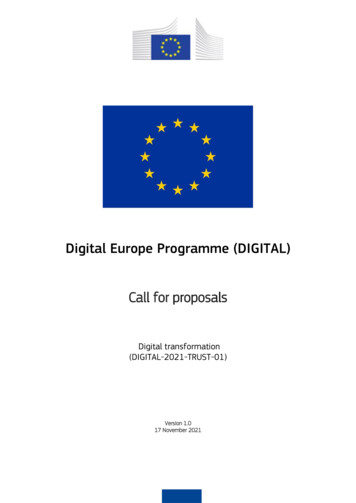
Transcription
THE DIGITALDENTISTDIGITAL WORKFLOWLEADS TO IMMEDIATEIMPLANT PLACEMENTLearn how the right systemsand software can lead to afaster final outcome.WHAT CBCTCAN REVEALDiscover why 2Dimaging sometimesisn’t enough.SYSTEM AND SOFTWAREINTEGRATION LEADS TOGREATER EFFICIENCYFrom evaluation to treatmentplanning, integration makes abig difference.
FACT SHEETDr. Beat R. KurtDr. Beat R. Kurt received his Master’s degree indental medicine in 1990 from the University ofBern, and completed his postgraduate educationin oral surgery at the clinic of dento-maxillosurgery at Central Hospital of Lucerne. Hecurrently specializes in implantology, guidedimplant surgery, soft tissue management andbone augmentation and is a referral for oralsurgery, complex reconstructive dentistry andsynoptic dentistry.Dr. Kurt has been in private practice for 20 yearsin Lucerne, Switzerland, and has over 12 years ofexperience working with various guided surgerysystems. He currently uses the Camlog andStraumann implant systems in his practice, andhas three years of experience in using acomplete digital workflow.CLINICAL CASE STUDYIMMEDIATE IMPLANTATION ANDRECONSTRUCTION: A COMPLETEDIGITAL WORKFLOWLEARN HOW THE RIGHT SYSTEMS AND SOFTWARECAN LEAD TO A FASTER FINAL OUTCOME.OVERVIEWA 54-year-old patient was referred to our practice and presented with an externalgranuloma on tooth #21. The patient’s periodontal situation was healthy.Our solution: immediate anterior tooth replacement using Carestream Dental‘sCS 3600, smop by swissmeda and exocad.TREATMENTInitial photo, radiograph, and intraoral scanInitial examination records included intraoral and extraoral images, intraoralradiography, a cone beam CT scan and a CS 3600 intraoral scan of both themaxillary and mandubular arches including bite registration.The .PLY file from the CS 3600 scan was imported into Meshmixer software as thevirtual wax up. The file was modified to virtually extract tooth #21, and was exportedas an .STL. The .STL file was then imported into smop software as the final digitalmodel to plan the implant placement and design the surgical guide.Implant planning in smop showing a combination of the CBCT datawith the intraoral scan
Virtual extraction of tooth #21 for the design and production of the surgical guideExport of the .STL data of the scan body, model and wax up for the manufacturing of theprovisional crownSURGICAL GUIDE & IMPLANT PLANNINGNext, the Camlog implant for tooth #21 was planned in smop software, including placement of the screw-retained crown and virtual contruction of the surgical guide template.Once the planning and design of the implant placement and surgical guide was complete, the files were exported as a digital model in both .STL and .PLY formats, and as a.PLY wax up showing the virtual scanbody. Next, a print was made of the guide template using a 3D printer from Stratasys (Eden260 – material: MED 610).The data was then imported into exocad software and the PMMA crown was designed and constructed using a Camlog glued-on titan base abutment.Import of the .STL data of the scanbody, modeland wax up in exocad softwarePrefabricated provisional crownCamlog Guide systemEXTRACTIONThe tooth was extracted, and a 4.3mm, 13mm Camlog Conelog implant was placed using the printed smop guide. The buccal defect was then filled with Bio oss collagenfrom Geistlich. The flap was repositioned, and the temporary screw retained crown was placed.Extraction of tooth #21
GUIDE PLACEMENT AND IMPLANT POSITIONINGPlacement of Camlog Conelog implant using Camlog guide systemFinal placement of the temporary screw-retained crownBefore-and-after treatment comparisonPerioperative care included antibiosis with amoxicilin and clavulan acid for one week, chlorhexidin 0.2% and mefenamin acid. Sutures were removed one weekafter implant placement.CONCLUSIONAfter 12 weeks, the referring dentist placed the permanent crown to complete the restoration.Follow-up intraoral photo and radiographFinal rest L6, LL7 and LR6 following 3-month integrationLL6, LL7 and LR6 with healing abutments following 3-month integrationAfter two more weeks, the lab delivered the screw-retained restorations, and we fitted them. We chose shade A3 and took an impression of the opposing arch todetermine bite.Placement of screw-retained restorationsOUTCOMEBy the end of treatment, the patient was delighted with the outcome. From the professional team’s perspective, there were no complications orunexpected events, which we can attribute to both meticulous planning and the harmony with which our team worked.Post-op periapical X-rays
FACT SHEETJean-Michel Foucart, D.D.S.Jean-Michel Foucart holds his D.D.S. degree aswell as a master’s and Ph.D. in oral andmaxillofacial imaging. He’s also an orthodonticspecialist. He opened his office in Eaubonne,France, in 1992. He’s also: A n associate professor in oral and maxillofacialanatomy and imaging A hospital practitioner in orthodontics andmaxillofacial imaging A legal expert (Versailles Court of Appeal) A radiation protection expert adviser A n author of more than 120 nationalpublications and communicationsCLINICAL CASE STUDYTHE DIFFERENCE INTEGRATION MAKES INTHE ORTHODONTIC PRACTICEFROM EVALUATION TO TREATMENT PLANNING,INTEGRATION MAKES A BIG DIFFERENCE.OVERVIEWDr. Foucart is not a newcomer to digital imaging. In fact, he bought his first digitalpanoramic and cephalometric system in 1998. When a diagnosis called forcomputerized tomography (CT), Dr. Foucart used a system at the university. In 2007,he transitioned to cone beam computed tomography (CBCT) with the CS 9000C 3Dto take advantage of the benefits the technology offered: higher resolution, fasterprocessing, a lower dose—and the convenience of having an in-house system.He later moved to the CS 9300C to benefit from a larger 3D field of View.THE IMPORTANCE OF CBCTWhen asked what capabilities he values in a CBCT system, Dr. Foucart replied,“We should always strive to seek the lowest dose possible while still obtaining thenecessary diagnostic images. A CBCT system with multiple fields of view—like myCS 9300C—helps doctors achieve that goal. In addition, the system should providetrue panoramic and cephalometric imaging.”Dr. Foucart also appreciates a system that provides automatic cephalometric tracing.“Tracing facilitates diagnoses,” he said. “With a system that does it automatically,you save a lot of time. The feature registers each anatomic landmark, and accuracyis about 80 percent. There’s no need for a time-consuming manual analysis.”Dr. Foucart appreciates the improved view of impacted cuspids that CBCT imagingprovides. He can determine the presence of ankylosis, which panoramic imagingdoes not reveal. “With 2D imaging, I can see only the frontal and lateral, but with3D I can see the entire form and analyze the relationship between the teeth and themaxilla, as well as the roots and whether they cross,” said Dr. Foucart.“I can determine the exact angle of the tooth.”True panoramic and cephalometric imagingCBCT systems provide an improved view of the cuspids
His patients can more easily understand their clinical situation—especially when there are impacted cuspids or serious concerns—from the images generated by theCBCT system. Plus, referrals can choose from the images Dr. Foucart has already taken, preventing the need to reimage the patient.THE SPEEDINESS OF THE CS 3600Dr. Foucart has been working with the CS 3600 intraoral scanner since January 2016. He loves the speed of scanning as well as the ability to immediately view thedigital model on the screen. And thanks to CS Model , he can analyze the entire scan within minutes. “Creating a digital model with an intraoral scanner is muchfaster than traditional methods,” said Dr. Foucart. “Taking the conventional impression, pouring in plaster, sending the impression to a lab and then waiting fordelivery of the model is not an efficient process.”The CS 3600 increases efficiency in additional ways, too. For example, the CS 3600 can export 2D .JPEG images directly into the patient’s imaging chart from the 3Dimpression. This powerful integration between the CS 3600 acquisition software and the patient’s imaging chart eliminates the need for the practice to acquiretraditional 2D orthodontic intraoral photographic records for the patient’s chart.HD 3D digital impressions acquired with CS 3600Dr. Foucart’s staff typically scans 7-8 patients per day and can complete both arches in about 5 minutes—although they’ve completed the process, including apalatal scan, in as little as 3 minutes, 13 seconds before.From the patient’s perspective, intraoral scanning is significantly more comfortable than a conventional paste impression. Gagging is no longer an issue, whichgreatly hampers productivity because you have to start the acquisition process all over and hope that gagging doesn’t happen a second time. Patients also enjoyseeing the images as they appear on the computer in real time.Dr. Foucart values the open file format of the CS 3600’s output: a digital file is more useful and can be sent as is for printing to a third party or in-house.Additionally, open files provide the practitioner with the freedom to share the files with labs or referrals without any restrictions. Labs or referring doctors can usetheir CAD software of choice to view and utilize the data sets.To more efficiently store models, Dr. Foucart previously scanned them with his CS 9300C and then used CS Model to create a digital version. But now his staffcan take the digital impression file acquired by the CS 3600 and use CS Model to create a digital model—a much faster and more concise process whicheliminates the need for a conventional impression.Dr. Foucart finds CS Model to be very useful in analysis. CS Model automatically segments the teeth on thedigital model in about one minute. The segmentation is automatic, and Dr. Foucart merely has to confirm thatthe segmentation is correct. CS Model then automatically creates a setup, which is essentially a treatmentsimulation. Generating the setup takes the software approximately one minute and then 2-5 minutes tosimulate different clinical possibilities in complex cases. This capability enables Dr. Foucart to provide each andevery patient a more comprehensive treatment analysis—without taking an undue amount of time tocomplete it. “Before CS Model , I did not produce a model analysis on all of my patients because it was tootime consuming. Now all my patients are checked in CS Model software. The result is a more comprehensivetreatment analysis,” said Dr. Foucart.Additionally, CS Model has been a helpful tool for more advanced treatment planning of complicated cases,which represent approximately 20 percent of Dr. Foucart’s patient base. The CS Model software enables himto perform multiple treatment setup simulations on a single patient and select the options that best meets thepatient’s needs. The simulation video also helps Dr. Foucart communicate the treatment goals to the patient,providing a helpful visual of how the treatment is likely to proceed.CS Model A SMARTER WAY TO WORKEach system and software solution has its own benefits it brings to the practice. But the truly noteworthy advantage lies with the gains in efficiency andinformation from the integration between them all. “There is a huge benefit to the workflow when all the products and software are designed to worktogether seamlessly. For example, I can now analyze all of my patient’s orthodontic records very quickly—in less than five minutes,” said Dr. Foucart.“How? I start with my auto-tracing from the ceph system. Then I launch the auto-segmentation feature in CS Model . I verify the segmentedand numbered teeth. Next, I launch the auto-set-up capability and modify my set-up criteria for the treatment when required. When I run the report, thevalues from the automatic tracing automatically merge into CS Model . The findings from CS Model include the relevant information, so there is no needfor me to manually enter the results from the cephalometric analysis. This not only saves time, but also prevents human error.”Dr. Foucart’s practice truly is experiencing the gains in efficiency that systems and software integration brings. The streamlined workflow, with allcomponents synchronized and working in harmony, enables Dr. Foucart to spend the optimal amount of time with his patients. His patients value thecomprehensive diagnostic analyses and treatment plans—complete with images. “All of the information provided by my systems and software enables meto feel confident in my diagnosis and my patients to feel confident about accepting treatment,” said Dr. Foucart.
WORKFLOW INTEGRATION I HUMANIZED TECHNOLOGY I DIAGNOSTIC EXCELLENCEFor more information, visitcarestreamdental.com 2018 Carestream Dental LLC. 16741 AL DDM Digital D. 0117
Placement of Camlog Conelog implant using Camlog guide system CONCLUSION After 12 weeks, the referring dentist placed the permanent crown to complete the restoration. Perioperative care included antibiosis with amoxicilin and clavulan acid for one week, chlorhexidin 0.2% and mefenamin acid. Sutures were removed one week after implant placement.











